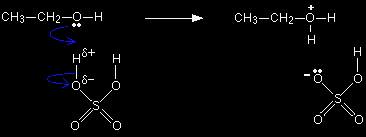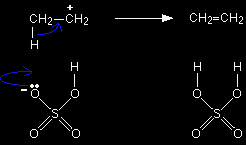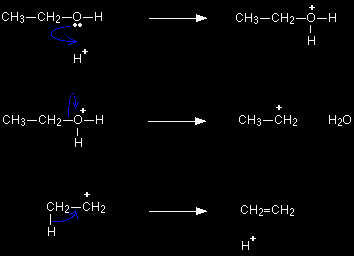THE DEHYDRATION OF ALCOHOLS
This page gives you the facts and a simple, uncluttered mechanism for the acid catalysed dehydration of a simple alcohol like ethanol to give an alkene like ethene. If you want the mechanism explained to you in detail, there is a link at the bottom of the page. You will also find a link to a page on the dehydration of more complicated alcohols where more than one product may be formed. The dehydration of ethanolThe facts Ethanol can be dehydrated to give ethene by heating it with an excess of concentrated sulphuric acid at about 170°C. Concentrated phosphoric(V) acid, H3PO4, can be used instead.
The acids aren't written into the equation because they serve as catalysts. If you like, you could write, for example, "conc H2SO4" over the top of the arrow. |
|
|
Note: There are many side reactions which go on at the same time. These aren't required by any current A' level syllabus. |
|
The mechanism - the full version We are going to discuss the mechanism using sulphuric acid. Afterwards, we'll describe how you can use a simplified version which will work for any acid, including phosphoric(V) acid. In the first stage, one of the lone pairs of electrons on the oxygen picks up a hydrogen ion from the sulphuric acid. The alcohol is said to be protonated.
The protonated ethanol loses a water molecule to give a carbocation (a carbonium ion).
Finally, a hydrogensulphate ion (from the sulphuric acid) pulls off a hydrogen ion from the carbocation.
The mechanism - a simplified version People normally quote a simplified version of this mechanism. The only Exam Board to want the mechanism for the dehydration of alcohols (AQA) is happy to accept this version. Instead of showing the full structure of the sulphuric acid, you write it as if it were simply a hydrogen ion, H+. That leaves the full mechanism:
An advantage of this (apart from the fact that it doesn't require you to draw the structure of sulphuric acid) is that it can be used for any acid catalyst without changing it at all. For example, if you use this version, you wouldn't need to worry about the structure of phosphoric(V) acid. |
|
|
Note: Although most people probably write the mechanism in this form, it is actually quite misleading because it suggests the possibility of a free hydrogen ion in a chemical system. A free hydrogen ion is a raw proton and this is always attached to something else during a chemical reaction. Personally, I find this simplification sloppy - but if your examiners are happy to accept it, who am I to argue! Go for the simple life! |
|



